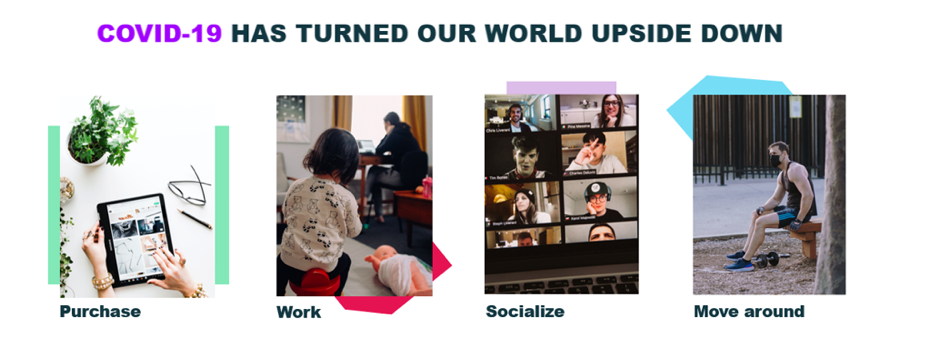Other parts of this series:
The swift response of many insurers to the COVID-19 pandemic has highlighted an abundance of opportunities for carriers to enhance the services and support they provide their customers, employees and local communities.
Insurance providers have rolled out an array of innovative solutions. They include COVID-19 tracking apps; specialized cover for healthcare workers; premium reductions for drivers, homeowners and small businesses; extensive online support for customers and vast digital communications networks for employees working from home.
While the pandemic is confronting insurance executives with plenty of big challenges, as I discussed in my previous blog post, they also need to remain alert to how they can improve the social and economic performance of their organizations. Critically, they should to be attentive to the major changes in consumer behavior that have been triggered by the pandemic and the social distancing measures introduced in most countries.
Indeed, this crisis has changed forever our experience of being a customer, an employee, a citizen and a human being.
Shifts in customer behavior in the wake of the COVID-19 pandemic was one of the key topics discussed among senior insurance executives from across Europe at our annual Digital Insurer Network meeting. A study conducted by Accenture, and presented at the meeting, identified five major factors changing customer attitudes. Each of them has important implications for insurers.
- The cost of customer confidence and trust. The future has rarely been so uncertain, and people are looking for backup plans and reinsurance options. The pandemic has given insurers an opportunity to draw closer to their customers to help them mitigate economic hardship and to also provide them with additional support services. The erosion of confidence will make trust even more important. Insurers should look for “trust multiplier actions,” such as providing proactive advice and guidance, that build on the trust they have already fostered with their customers. Such initiatives will help insurers establish themselves as long-term trusted partners.
- Digital century. “If I can do it online, I will.” Consumers have flocked to using the online facilities offered by service providers and retailers. They’re unlikely to return to their previous habits. The enforced shift, during the worst of the pandemic, to online working, consuming and socializing will accelerate a migration to virtual living. Anything that can be done virtually, will be. Far-sighted insurers will gain a lead on their competitors by exploring and testing all sorts of creative possibilities that capitalize on this shift to the virtual world.
- Every business is a health business. “Looking after my health and my family’s health is a priority.” People’s concerns about health that were amplified during the COVID-19 pandemic will not recede once the crisis is over. Instead, health and wellbeing will dominate people’s lives. A burgeoning health economy will emerge that will provide plenty of opportunities for insurers. Every insurer will need to understand how it can be part of the new health ecosystem. There are already lots of opportunities. This is clear from the submissions to this year’s Efma-Accenture Innovation in Insurance Awards. I’ll discuss some of these innovations in a forthcoming blog series.
- Cocooning. “Home is where the threat is least and where I’m safest…” The desire among consumers to cocoon at home has accelerated dramatically during the COVID-19 crisis. It will be an increasingly important trend for insurers. Successful carriers will set their sights on the home. They’ll deliver premium services and experiences that satisfy the longing among consumers to dwell in their cocoons.
- The reinvention of authority. “We need to do what we are told; it’s in our best interests. But I want to see companies do the right thing.” A reinvention of authority will probably occur as a result of the travel limits, self-isolation and lockdown mandated by many governments. This is likely to be the trickiest of the five shifts in customer behavior to anticipate. It’s a trend that could take one of two very different directions. If governments handle the crisis well, we can expect a return to “top-down” approaches to governance and administration in many countries. If they don’t, the reverse may happen. Among big businesses, shifting employees to working from home has subtly altered long-standing beliefs about leadership. Employees at lots of companies played a key role in devising and implementing new ways of working and improving performance. Many of the executives I spoke with during our (virtual) Digital Insurer Network meeting are looking at further empowering their employees and developing more agile workforces.
Of course, not everyone is reacting to the COVID-19 pandemic in the same way. Smart customer segmentation continues to be important. My colleagues at design and innovation consultancy Fjord recently conducted a very interesting analysis of customer responses to the pandemic. They identified five types of customers, each of whom has a very distinct mindset that drives their behavior (See illustration below).
Nonetheless, the “new normal” experienced by all customers will be very different from their previous ways of living. The sudden acceleration, in six to eight weeks, of trends that have been shaping the insurance industry for many years will open a myriad of opportunities for carriers. Successful carriers will seize these opportunities by quickly changing their business models and empowering their employees to work in new ways.
I’ll discuss some of these opportunities in my next blog post. Until then, take some time to look at the links below. And, stay safe.
Covid-19: Navigating the human and business impact on insurance carriers












